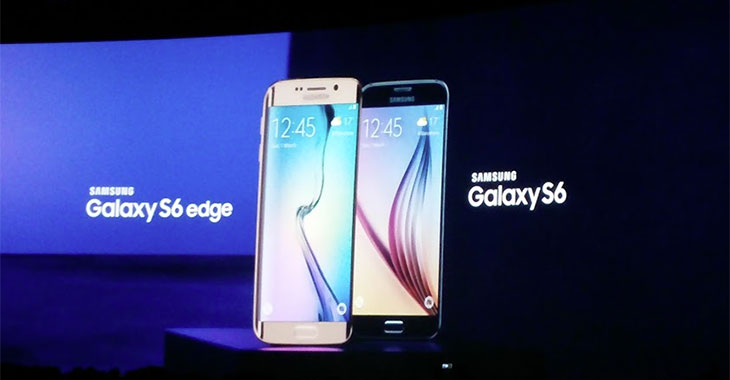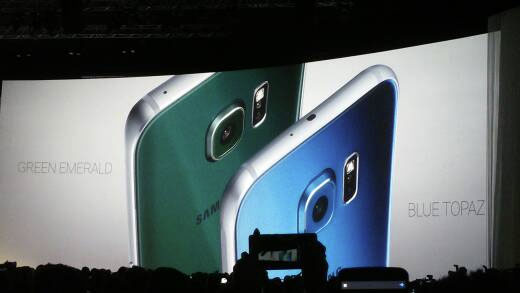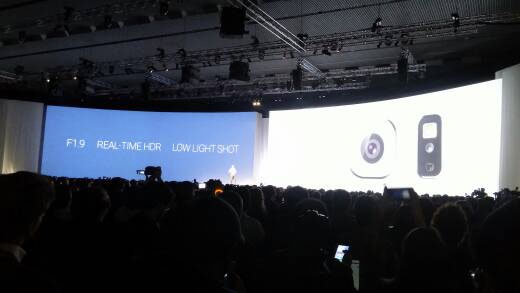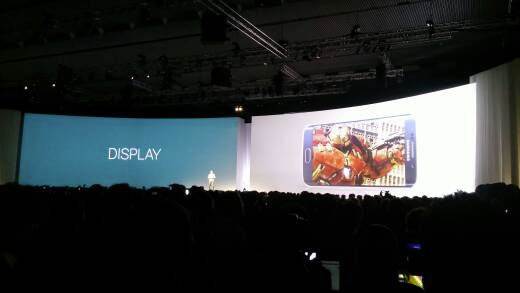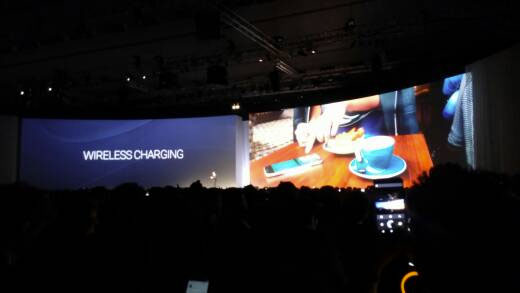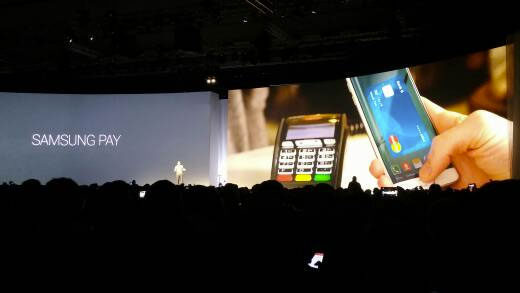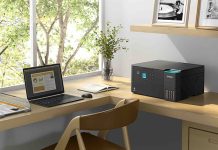Samsung has launched its vision of “what’s next” at Mobile World Congress, setting the tech world buzzing once again. The latest evolution of the Galaxy S line, the Galaxy S6, will arrive in April in two variants – the Galaxy S6 itself, and a dual edge-display variant, the Galaxy S6 Edge.
The company has made a number of significant changes to the construction of the phone, including a metal frame, glass back and sealed-in battery, matching rumours we’ve heard over the last few months. The Galaxy S6 Edge is just 7mm thick, and the Galaxy S6 is even thinner still.
The result is a couple of handsets that, while still bearing the distinctive “Samsung phone” design, look great in their own right with smooth surfaces and simple curves hiding the advanced technology within. The look and feel screams “premium”, and that can only be a good thing when it comes to putting phones in consumers’ hands.
Samsung has five colours coming out so far: White Pearl, Black Sapphire, Gold Platinum, Blue Topaz and Green Emerald, and it’s the last two that you really want to pay attention to. Besides calling to mind the way Android 5.0 Lollipop embraces vibrant colours, Samsung says they want to evoke “shimmering colours, with a mystical quality”. When they popped up on screen, I certainly sat up and took notice – I don’t really go for black or white phones any more, and gold seems a bit tacky to me. Topaz Blue’s where it’s at for me.
Camera
Samsung has clearly paid special attention to the S6’s cameras. With the realisation that practically everyone is using their phone as their camera now, Samsung’s moved the needle significantly in camera performance and says the S6’s camera works great in all lighting conditions rather than just low light – but nailing low light performance still makes for great product demos, especially when it’s at the expense of competitors’ phones.
Firstly, both the front and rear cameras now feature f/1.9 lenses to capture more light, faster. The front camera shoots 5MP, while the rear camera hits 16MP with Optical Image Stabilisation. It’s a similar unit to the one seen in 2014’s Galaxy Note 4, but with the f/1.9 lens it should be capable of some amazing things. Hopefully they’ve allowed a wider field of view on it.
Some of the demos, shot in crowded bars and some of Barcelona’s night scenery were pretty striking, and if the camera can live up to these promises then I’ll be happy to walk down the street with an S6 in my pocket.
There’s also a quick launch feature – double clicking the home button now launches the camera, so you should be able to get to the camera from anywhere, and be ready to shoot in under 1 second.
Display
In what could be an acknowledgement that phone screen sizes don’t need to get any bigger, the S6’s screen remains at 5.1 inches.
Unsurprisingly, Samsung’s proud of its Super AMOLED quality and it’ll also feature on the Galaxy S6. The S5 had one of the best screens around on on mobile devices, and the display has been bumped to QHD for the S6, matching the Note 4’s resolution.
The S6 Edge’s screen is a “dual curve” edge display extending down both sides of the screen, a step up over 2014’s Galaxy Note Edge which only featured the edge display on the right edge. The Edge display has some neat software tricks in the offing, too.
Processor, RAM and Storage
As smartphone specs begin to plateau, it’s not too surprising to see little attention given to the technology that powers them. Samsung’s using a 64-bit octa-core CPU in the S6, with quad-core 2.1 Ghz and quad-core 1.5 Ghz parts, but they’ve been cagey about naming the manufacturer, naming neither Qualcomm nor their own Exynos series.
That said, it does seem likely we’ll see Qualcomm CPUs in Australia again and Exynos CPUs in some overseas markets but these details will emerge closer to launch.
Samsung’s pushing RAM and storage technology forward in the S6 as well, with LPDDR4 RAM and Universal Flash Storage 2.0 in use to boost system and storage performance.
The result? Samsung’s promising a lag-free experience. “Insanely responsive” was the actual quote.
There’s another change to the storage that will upset a number of users – the Micro SD slot is gone.
Battery
The biggest change with the battery is that they’re now sealed into the phones, instead of Samsung’s traditional removable, replaceable batteries. Samsung says they didn’t want to do this until they could get power consumption and charging capabilities correct.
Samsung’s main focus in battery was on the quick charge capabilities, which they say are faster than anyone else around – you can get 4 hours of use out of 10 minutes of charging, great for times when you’re hopping between places that might have a power socket here and there.
In terms of actual capacity, the batteries in the two phones differ by 50mAh – 2,550 mAh for the S6 and 2,600 for the Edge.
The other main news is that both phones can be charged wirelessly, putting an end to the need to find the right pad for your phone and ensuring its compatible with your case.
Software
In contrast to presentations in years past, Samsung spent little time in the presentation on the software. In fact, the whole presentation was over pretty quickly.
The company says they’ve taken into account UI changes suggested by customers and by their “friends on the Internet” (they might be talking about us?).
While moving up to Lollipop and embracing Material Design for their core apps, Samsung says they’ve also tried to make the UI more intuitive, and simpler to use. They say they’ve simplified the logical structure and reduced depth, removing things that got in the way of you using the phone like unnecessary notifications.
Hopefully this means the messy Settings systems we’ve seen on Samsung devices in the last 12 months are gone, but that’s also something they’d get simply by moving the platform up to Lollipop. We’ll have to wait until we get some hands-on time to see how this change pans out for end users.
Throughout the core apps, Samsung’s made conscious design choices around things like colours, so you can visually associate apps that deal with the same features like contacts, video and more.
The colour association extends to the edge displays on the S6 Edge. You can assign colours to contacts, and when the phone is face down the edge display will glow with the relevant colour when an incoming call or text comes in. Another neat trick is the use of the heart rate monitor to send an automatic reply when you can’t answer a call while in a meeting.
Some particular attention was paid to the camera interface – a particularly sore point in the company’s 2014 models (for me at least). Samsung says they’ve made it easier to recognise what icons do by adding labels to them so you can spot and identify them faster — but that does somewhat miss the point of design iconography (it should be obvious what your icon is for by its design, and it shouldn’t require a label).
Icon design and labelling aside, the newest updates to the camera UI seem to make for a much cleaner and more intuitive experience more by placement of icons and functions rather than labelling, and that’s a-okay with me.
Samsung Pay
Less relevant for Australia at the moment as it’s launching only in Korea and the US – that we know of, anyway – is Samsung Pay, Samsung’s mobile payments solution. It uses both NFC and MST (magnetic secure transmission) technology to allow it to work even where a merchant can’t accept NFC payments, giving it a leg up on compatibility and making it “card issuer agnostic”.
Samsung says that Samsung Pay will be accepted by more merchants than any other mobile payment offering at launch – it’s a bold statement, but bridging the gap by including MST will definitely help with acceptability. But, that seems pretty focused on the USA. We’ll see how things evolve when Samsung rolls out Samsung Pay here … at some point.
Security
Samsung’s beefed up their Knox security suite for the S6. They’re ready for immediate enterprise adoption and work with all major device management systems.
Launch information
The Galaxy S6 will roll out in 32, 64 and 128GB flavours in 20 countries on 10 April. We’re assuming Australia will be in the first 20.
Following the announcements live at MWC 2015, Samsung Australia’s Vice President IT & Mobile, Prasad Gokhale says:
I’m very excited to confirm that the Samsung Galaxy S6 and Galaxy S6 edge will be arriving in Australia shortly. The new devices integrate some of Samsung’s newest cutting edge technology to help make the lives of Australians more efficient every day. I look forward to sharing more information closer to the launch date.
As we receive advice on availability in Australia from Samsung, and from Australia’s mobile carriers, we’ll keep you updated.
Note: Press images of the phones weren’t supplied, and Samsung’s PR site is having issues at the moment. We’ll add official images of the phones when they become available to us.

